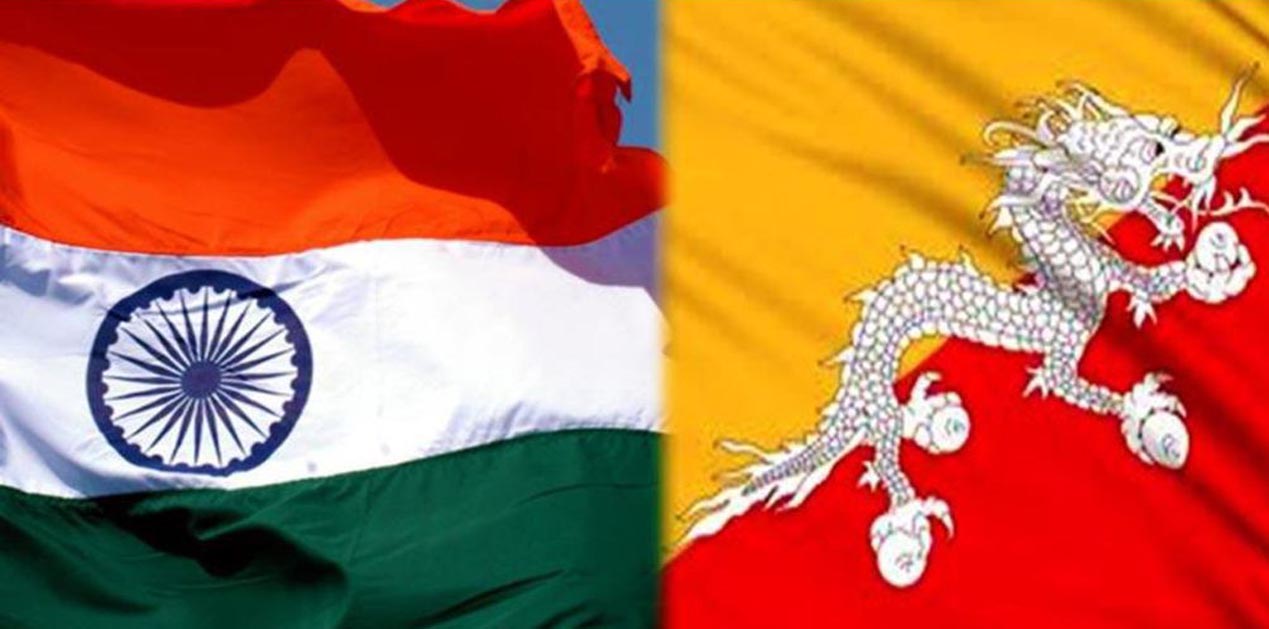Bhutan is an important neighbour and recently appointed India’s External Minister S. Jaishankar chose to visit Bhutan for two days (7th-8th June) as his maiden bilateral visit. This visit facilitated the tradition of regular visits and exchange of views at the highest level between the two countries. PM Narendra Modi in his earlier tenure introduced the ‘Neighbourhood First Policy’ and had also chosen Bhutan as the destination of his first foreign visit in 2014. In 2018, the newly elected Prime Minister of Bhutan Dr. Lotay Tshering reciprocated, similarly by choosing India for his maiden visit.
During his visit, External Affairs Minister (EAM) received an audience with Bhutanese King Jigme Khesar Namgyel Wangchuck, he also called on Bhutanese Prime Minister Dr. Lotay Tshering. The EAM also met his counterpart Lyonpo Dr. Tandi Dorji and discussed on various bilateral issues especially related to developmental partnership and hydro-power cooperation. There has been an upswing in the relationship between the two countries in recent years. During the visit, the emphasis was laid on giving a new thrust to the time tested friendship. India is the highest contributor of foreign aid and investment in Bhutan and also its biggest trading partner.
Hydro-Power is one of the main areas of cooperation between India and Bhutan. It is the centre-piece of economic relations between both the countries. It is the highest contributor to Bhutan’s GDP and India has been actively involved in helping Bhutan in building several hydro-electricity plants. Bhutan is a water-rich country and has the capacity to generate 30,000 MW of hydro-electricity every year.1 India has been assisting Bhutan in achieving this target. India and Bhutan signed the first hydropower cooperation pacts in 1961 to harness the electricity from the waters of Jaldhaka river.2 The Chukha Hydro-Power Project (CHP), commissioned in 1987, was a watershed moment in India-Bhutan hydro-relations. Bhutan assumed the complete control of this plant in 1991. 3 In 2008, the two sides signed a Protocol to the 2006 Agreement on Cooperation in the field of Hydro-electric Power (HEP) to enhance the export capacity of Bhutan to India from 5,000 MW to 10,000 MW by the year 2020.4
Hydro-power is also the main area of concern between India and Bhutan. One of the greatest concern for Bhutan’s economy is its rising hydro-power debt. According to the annual report of 2016-17 by the Royal Monetary Authority of Bhutan, its total’s debt to India is about Rs. 118.77 billion and of this 94.11% comprised of outstanding public debt on hydro-power project. 5 The export tariffs from the hydro-power project is also a concern for Bhutan and it is seeking increase in it which will help it in decrease its debt and dependence on India and increasing its earnings. No agreements have been reached in this area despite several rounds of talks between the two countries.
The current government of Bhutan formed by the Druk Nyamrup Tshogpa (DNT) party, had mentioned in its manifesto that it wants to reduce Bhutan’s excessive dependence on hydro-power which its exports to India. Its manifesto, had stated, “We acknowledge the central role of the hydro-power sector in our economy, however, since it is a climate sensitive sector and considering possible geo-climatic hazards in future, it would be unwise to hinge the country’s economy solely on a single sector.”6 This statement shows the intent of the current ruling regime of Bhutan and China can be the answer to their diversification question. Although Bhutan trade and economic engagement with China is very limited, with China export to Bhutan at Rs. 1,610 million and Bhutan’s export to China at only Rs. 1.46 million. The import of Chinese consumer goods to Bhutan is one-third of Bhutan’s total import of consumer goods.7 Clearly, China is trying to increase its footprints in terms of trade with Bhutan.
The increasing Chinese footprints has become a major security concern for India. In the 72-days Dokhlam standoff, Bhutan supported India but there is a strong undercurrent in Bhutan to diversify its relations and dependence on hydro-power earnings. China sees this as an opening to enter Bhutan. China and Bhutan have no formal relations yet but there has been a rise in the high-level visit of Chinese official to Bhutan. China’s former Ambassador to India, Le Yucheng visited Bhutan in 2015, followed by a three-day visit by China’s Vice-Foreign Minister, Kong Xuanyou in 2018. During his visit, he invited Bhutan to join the BRI project and reap the benefits of ‘China’s Developmental Dividend.’ Recently, the Chinese Ambassador to India, Luo Zhahui also visited Bhutan in January 2019. During his visit, Ambassador Luo met Bhutanese King, Prime Minister Lotay Tshering and the Foreign Minister Tandi Dorji and discussed strengthening pragmatic cooperation in different fields and push for a new development of their bilateral relations.
China is using soft power diplomacy to increase its influence in the Himalayan kingdom. According to the report of Tourism Council of Bhutan, the number of Chinese visiting Bhutan has increased significantly from less than 20 a decade ago to 9,220 in 2016. Although the number dropped to 6,421 after the Doklam standoff, but it is still a significant number of the total 70,000 international tourists who visited Bhutan in 2017. The Chinese are using the tourists as an economic leverage as they understand that tourism is the second highest contributor to Bhutan’s GDP after hydro-power and is also the fastest growing industry. Arrival of a large number of Chinese tourists in China will lead to more people-to-people contact between the two states and help in generating a positive relationship between the two countries.
India needs to diversify its engagement in Bhutan and help Bhutan in growing and expanding its economy. India needs to change its role from that of being the largest developmental partner to becoming the largest investor in Bhutan. Bhutan plans to completely end dependence on foreign aid in its five-year plan and one of the goals of the12th five year plan is that this will be the last five-year plan with foreign aid and assistance. Bhutan wants to move away from the Less Developed Country group and India can help Bhutan in achieving it by making Bhutan economically more self-reliant. This will help in strengthening the bilateral relationship and counter the undercurrent of diversification within Bhutan. As has been seen earlier, China does not just limit itself to economic engagements but usually tries to leverage influence on the domestic and foreign policies of Bhutan. There is no immediate warning bell for India in Bhutan, but it’s always better to be safe than sorry.
Visit of S. Jaishankar clearly shows the intent of the present government and the importance Bhutan holds in the Indian Foreign Policy. India wants to consolidate its relationship with its neighbours in South-Asia. India understands the importance of its neighbours in the current world order in which China is expanding its influence across the globe. Bhutan is also India’s doorway to South-East Asia. South-East Asia and BIMSTEC have gained more prominence than SAARC in the current regime and the invitation to leaders from BIMSTEC along with President of Maldives and Kazakhstan for the swearing-in ceremony shows that India is looking towards BIMSTEC as a new area which can help in bridging the gap between South-Asia and South-East Asia. BIMSTEC will be a platform which will act at a convergence of India’s ‘Neighbourhood First’ and ‘Act East Policy’.
In his first public appearance after assuming office while addressing a session on “Changing World, Changing India”, S. Jaishankar said that India will work on the regional integration and connectivity in South-Asia and South-East Asia. Integration of South-East Asia with South-Asia could be mutually beneficial towards the development of both the regions. South-Asia and BIMSTEC will be the two main pillars of the foreign policy of the present government.
References:
- https://www.hydropower.org/country-profiles/bhutan
- https://sari energy.org/oldsite/PageFiles/What_We_Do/activities/Bhutan/Overview_of_Bhutan-India_Cooperation_in_the_Power_Sector.pdf
- https://www.mfa.gov.bt/rbedelhi/?page_id=28
- https://www.mfa.gov.bt/rbedelhi/?page_id=28
- https://www.rma.org.bt/RMA%20Publication/Annual%20Report/annual%20report%20%202016-2017.pdf
- http://www.druknyamrup.info/manifestos/
- http://www.nsb.gov.bt/publication/files/SYB_2018.pdf
(The paper is the author’s individual scholastic articulation. The author certifies that the article/paper is original in content, unpublished and it has not been submitted for publication/web upload elsewhere, and that the facts and figures quoted are duly referenced, as needed, and are believed to be correct). (The paper does not necessarily represent the organisational stance... More >>
Image Source: https://slideplayer.com/slide/13521800/82/images/1/INDIA+%E2%80%93+BHUTAN+Relations.jp










Post new comment